Magdalene College Cambridge in 1964: a reminiscence in photographs
On becoming an undergraduate at Magdalene College Cambridge in October 1964, I took a number of photographs of my surroundings, supplemented by occasional snaps of College scenes during the three years in which I was in residence.
Some of these pictures form this presentation. Obviously, I was never an ace photographer and the passage of Time has not added to the clarity of some of the images. I can only plead that many of the pictures were taken on autumn and winter days, when Cambridge does not always show itself at its best. I am encouraged to use them by the thought that, back in 1964, I should have been interested to see photographs of Magdalene sixty years before – although, of course, 1904 would have seemed prehistoric. Some of my pictures are timeless, but others are reminders that the College has changed a great deal – and for the better – over the past six decades. Indeed, in 1964, it was in the process of change (if not always very obviously) and on the eve of further transformation.
In October 1964, the Magdalene community comprised about two dozen Fellows – I discuss the imprecision below – plus an unspecified but small number of other senior members, 257 undergraduates and a rather lonely 41 postgraduates. In 2022, there were approximately around one hundred senior members formally associated with the College, three-quarters of them active or retired Fellows, along with 350 undergraduates and around 200 research students.
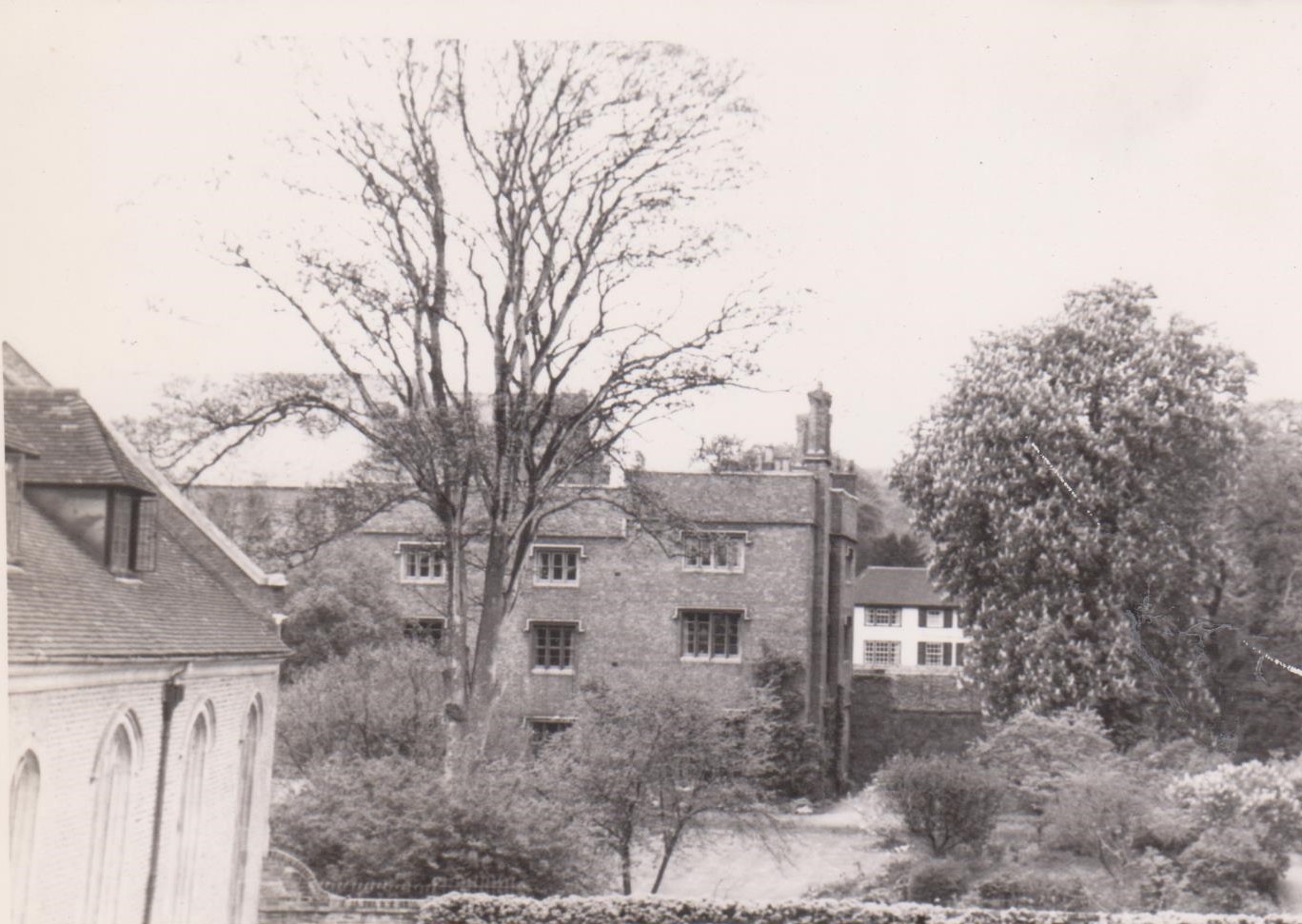
The old Master's Lodge In 1964, the now-vanished Master's Lodge loomed large, as shown in this view taken from G Staircase in Bright's Building. Designed by J.C. Buckler and erected between 1835 and 1837, it was essentially a Victorian vicarage designed for a clergyman with a large family: George Neville-Grenville, the Master for whom it was provided, was a pluralist and father of eleven children. Architectural guides describe the style as "neo-Tudor" (as the picture shows, it had some twiddly brick chimneys) but it struck me as resembling a cardboard box. In 1964, the Master's Lodge was occupied by the beaming and booming figure of Sir Henry Willink, who had sat briefly in Churchill's cabinet and would occasionally, when even more expansive than usual, share his recollections of "Winston". He took his social responsibilities seriously, and each undergraduate was invited to Sunday breakfast, which was something of an ordeal for those who were not early risers. One of the peculiarities of the Master's Lodge was that the kitchens and dining room were connected by steps. How it was possible to have created a building with different levels in one of England's flattest counties, I do not know. No doubt this was not a problem in the era when servants were cheap, but Sunday morning student guests were conscripted to manoeuvre the breakfast trolley through the grim passages. Not long after this photograph was taken, the Governing Body decided that the Lodge no longer served its purpose, and the building was demolished. Despite fears that it was on the point of collapse, the old Master's Lodge put up a considerable resistance and weeks of excavation were required to remove its foundations.
There was a bizarre tailpiece to the demolition. 1967 saw the publication of a volume of extracts from the diaries of Joseph Romilly, a nineteenth-century Fellow of Trinity who was an immobiliser and stabiliser in University circles. (Cambridge in those days discouraged shakers and movers.) In 1835, Romilly had attended the ceremonial setting of the foundation stone for the new Magdalene Lodge, and his diary revealed that a gold sovereign had been placed under the engraved block. Since Magdalene's poverty was legendary, I alerted the Bursar, Jock Burnet, to see if the coin might be salvaged. In fact, he had already seen the entry, but had concluded that the treasure was gone. Its disappearance was hardly in the same disaster league as the loss of the College's Aldgate property in the sixteenth century but, nonetheless, a William IV gold sovereign would have fetched a few bob at auction.
Buckler's gaunt rectory was replaced, in 1966-7, by a new Mediterranean-style Master's Lodge. It stood on much the same site as its forerunner, but was designed to provide for the possibility of eventual conversion into student accommodation. The principal architect was a Fellow, David Roberts, a genial Welshman who had won plaudits for his humane adaptation of available space in Benson and Mallory Courts into Magdalene's "village" campus. Architects generally have foibles and, unfortunately, David Roberts was an enthusiast for flat roofs. The new Lodge undoubtedly looked clean and modern, but it was soon found that the flat roof was ideally designed for the provision of internal irrigation (it leaked). A pitched roof was added in 1979, an unwelcome expense. When the flat-roof saga was repeated in another Roberts project, Buckingham Court, in the early nineteen-nineties, his standing was posthumously reduced, although I prefer to remember his collegial charm.

The Hall. I freely admit that my photograph of the Hall, taken in October 1964, will win no prizes for creative camera work. In my defence, I plead that Magdalene's refectory was a gloomy place. The panelling was painted brown (or was it Brown Windsor?), hardly supportive of my attempt to capture the available light on an autumn day. All members of Magdalene were, of course, proud of our quirky distinction of dining by candlelight (was it poverty or perversity that had prevented the installation of electric light?), but smoke and greasy wax had left their dingy traces. Redecoration in brighter colours had to wait until 1979.
Hall was the place where undergraduates could study the Fellows en masse, especially on Sunday nights when they all dined. Indeed, it was easy enough to become familiar with their names and faces, because there were surprisingly few of them. A formal list from January 1968, for instance, gives a Fellowship of 24 members: indeed, into the early seventies, there seemed to be a superstition that the total (including the Master) should not exceed 25. (Not counting retired academics, Jesus College in 1959 had 32 Fellows and numbers were rising; King's in 1966 had 83.) In fact, the active core membership in 1964 was even smaller: a couple of names on the 1968 list were very recent elections, while three of the most senior held emeritus positions and were never seen. Magdalene was home to two Professorial Fellows, valued scholars who played their part in the academic community, but in that era it was unusual for the occupants of Chairs to hold major College offices. (J.A.W. [Jack] Bennett was Keeper of the Old Library, but as he held the Chair of Medieval English Literature, this was an understandable overlap and a relatively undemanding job.)
There were several disadvantages in having such a small society. Although the active Fellows were strongly committed to Magdalene as a teaching institution, the College could not supply Directors of Studies for all subjects that undergraduates chose to read. Thus the handful of students admitted each year to read Geography were well looked after by a Fellow of Churchill, but nonetheless there was some feeling that they were second-class citizens. More seriously, there was something of a hardening of the institutional arteries since the Magdalene Fellowship received little infusion of new blood. The atmosphere was hardly attractive to radical young academics, while it is likely that a sense of comfortable cohesion inhibited the recruitment of anybody who might rock the boat. Larger (and wealthier) colleges could risk more adventurous elections since a possible dissentient voice could, if necessary, be diluted – and might go off to a Chair somewhere else: some, such as King's, positively welcomed refreshing challenges. In 1964, the Master of Magdalene and three of the senior Fellows – two of them still very much around – had fought in the First World War. Others had taken part in the Second World War, on active service or through Intelligence work or scientific research. Undergraduate historians like myself were only aware that the veteran historian, Frank Salter (whom we rarely encountered anyway), had been wounded on the Western Front because he had lost an eye. We also knew that our Director of Studies, Ralph Bennett, had been engaged in Intelligence work during the Second World War. However, like most people of their age group, Fellows of Magdalene rarely talked of their wartime experiences: indeed, Ralph Bennett and Magdalene's maths don, Dennis Babbage, who had both worked at Bletchley Park, were still bound by the Official Secrets Act which shrouded the Enigma Project in mystery. Thus the core of Magdalene revolved about a dozen men who had worked together – or, at the very least, successfully co-existed – for around two decades, and some of them for even longer. It was hardly surprising that the College's centre of gravity, its default position, was essentially conservative, dedicated to running the machine along lines that seemed – to them, at least – to work. Several of the key players were in their fifties, settled in their lifestyles and determined to maintain existing ways at least until they retired. It was very rare for an established Fellow to move to another institution – no doubt there were opportunities in the 'sixties, but it is hard to imagine any member of Magdalene High Table helping to plan an interdisciplinary curriculum at a new plate-glass university. Since Magdalene was perennially poor, new Official Fellows – those who constituted the Governing Body – could only be recruited from younger academics who were on the University's staff payroll. Naturally, they had to combine commitment to the College with the need to concentrate on their careers. Magdalene was very fortunate that two of its recent acquisitions did take on College office. The botanist Peter Grubb, elected in 1960, became much the youngest of the four Tutors, while Ronald Hyam, elected two years later, accepted the office of Librarian, which was not, as I describe below, a humdrum chore in the book-free Magdalene of the early nineteen-sixties. I do not think I violate any secret if I say that both were committed to raising academic standards (Magdalene's examination performance was stubbornly below the University average), but I believe they recognised that change would come only slowly.
By the end of the 'sixties, Cambridge colleges placed more emphasis on electing research fellows, usually with a three-year tenure that acted as a stepping stone to an academic career. Most of the other colleges had comfortable incomes from their endowments; Magdalene did not. The College did have a pleasant custom of electing senior PhD students into one-year bye-fellowships, which gave the recipients – between one and three annually – free accommodation plus the privilege of dining at High Table. (The porters roguishly attempted to persuade new bye-fellows that they were not permitted to walk on the grass.) But research fellows, who had to be paid a stipend, were an innovation for Magdalene, and the College could only afford to elect one a year. In other colleges, research fellows were members of the Governing Body, and some of my contemporaries became entangled, willingly or otherwise, in the minutiae of institutional politics. Magdalene rigidly excluded its research fellows from any role in decision making, thereby further ensuring immunisation from new ideas.
Hence there were disadvantages to the small size and relatively closed nature of the Magdalene Fellowship. Nonetheless, the Fellows of Magdalene are entitled to retrospective tribute: they "delivered" teaching, as more recent jargon has it, protected student welfare (especially through the four Tutors, but also thanks to the College Chaplain, Simon Barrington-Ward, whom this atheist hails as an outstanding human being), ran the admissions process, coped with the pinched finances and yet somehow managed to refurbish old buildings and erect new ones. Had some external authority dared to impose radical surgery upon the structure of Cambridge, it might well have been tempted to merge struggling Magdalene into a larger entity. (Oxbridge still ran Whitehall, so any such intervention would have been highly unlikely.) As it was, the College survived to become the launch-pad for the institution that has so impressively renewed itself since the nineteen-eighties. Yet the basic point remains: the Magdalene Fellowship was too small, which meant that the College's administrative survival was hardly compatible with eager adjustment to change.
In addition to those evening candlelit dinners, I associate the Hall with one other Magdalene ritual. At the start of every Term, the four Tutors each held a formal meeting with their pupils, as we were called. (This, of course, was a very Cambridge term, since the Tutors were responsible for seeing that we were taught, but did not actually impart any learning themselves.) Thus on nine occasions over my three undergraduate years, I found myself wearing my gown and crowded on to the Hall benches with sixty other students of various vintages, many of whom I did not even know by sight. At the appointed hour, our Tutor strode in, his MA gown streaming authoritatively behind him. We rose in deference, as silently as possible, and were gestured to re-buttock ourselves on the hard woodwork. The session began with the calling of the register. This was a pricelessly funny ritual. The majority of Magdalene undergraduates came from public schools, where their years of puberty had been punctuated by frequent roll-calls. They had mastered the art of responding in a formally respectful manner that barely masked satirical sarcasm. It was always amazing how many variations in emphasis and combinations of the octave could be harnessed in uttering a two-syllable word – [tenor]PRES-[bass]zunt – Prez-UNT – and so on. Well down the alphabet came a languid and mellifluous young man, whose response sounded like the opening of Bach's D-Minor Toccata and Fugue played on the organ of the Albert Hall. It was a wonderful piece of aural theatre. I do not think that there were ever any absentees, and in saying that I do not hint at any practice of boarding-school ventriloquism. There followed various house-keeping announcements, such as lists of times when Directors of Studies would be available for consultation. The gathering closed with a short homily on the importance of studious diligence, and I do not envy any academic faced with the task of preaching to young men between the ages of eighteen and twenty-two. The audience were no longer impressionable adolescents (assuming that they ever had been), but had yet to enter the responsible years of career, mortgages and parenthood, to which inspirational appeal might eventually be made. The only counsel that I recall – I must have heard it three times – was that marriages were made in Heaven, but class lists [i.e. examination results] were made in the Lent Term. Unfortunately, the words lodged more deeply with me than the message. It is likely that these termly gatherings were a survival from Victorian times, when colleges provided teaching for their own students, and Magdalene used its Hall as a lecture room. Nowadays I expect such business is transacted by e-mail.
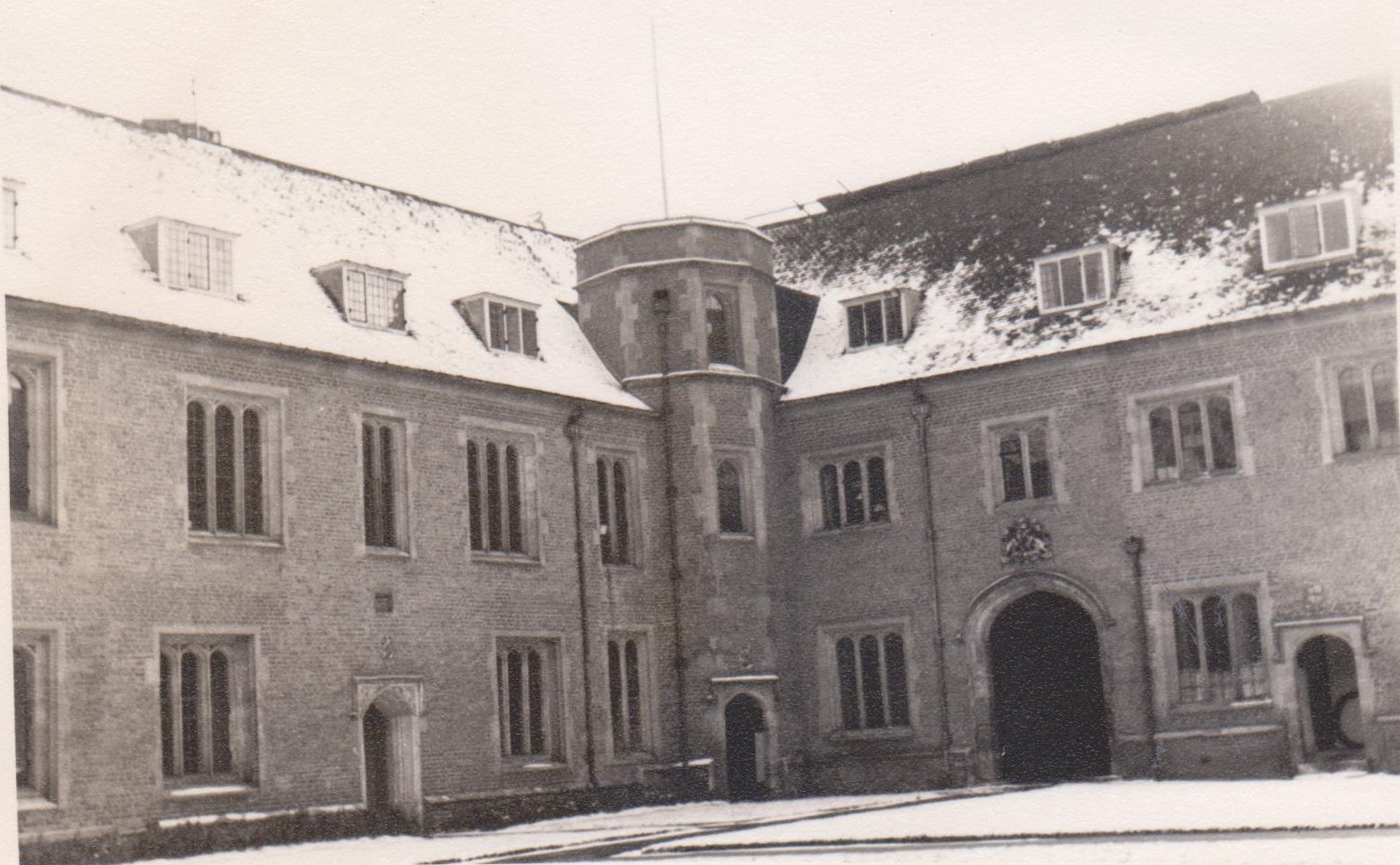
First Court in the snow. This is January 1965 and, again, I have to point out that Cambridge in midwinter is not remarkably photogenic. I also fully concede that, externally, my scene has probably barely changed in six decades. But, in fact, the picture was taken on the eve of mighty (indoors) changes. At the right-hand side is the entrance to B staircase which, in January 1965, was still a proper staircase, leading to student accommodation. However, that summer, the absurdly cramped porters' lodge was extended to annex the lower part, while the upstairs was remodelled as part of the Senior Tutor's office. In the corner of the court, C staircase was one of the hubs of College life. On the first floor was the College Office. There was always something reassuring about the warm gentle light from its windows (it is just detectable here), and the staff were friendly and helpful whenever a student had to visit. In fact, this happened relatively infrequently, although local authority grant cheques were issued over the counter at the start of each term.
The machine was run by two clerks who were both called, with impressive economy of nomenclature, Mr Brown. The elder Mr Brown was a rather solemn person. I believe he became a clergyman in later life, when he was succeeded by his younger colleague, the cheerily rubicund Mr Cyril Brown. Together, they produced termly College bills in which the various charges were entered in neat fountain pen on printed forms. I had won an Entrance Exhibition worth £40 a year, so £13, six shillings and eightpence was deducted from each bill. In addition, I recall that I had signed up to donate two shillings and sixpence (12.5 pence) each term to a boys' club in Camberwell which Magdalene had sponsored since Edwardian times. I rather wish I had kept those bills. Adjoining the College Office were the rooms of the Bursar, Jock Burnet. The Magdalene ethos emphasised the gifted amateur, and Jock was not a trained accountant, nor did he have business experience. However, he was extremely hospitable although – as the former editor of the Public and Preparatory Schools Yearbook – he did have his favourites. (I do not know why he was called Jock, since he was very English.)
The chief feature on the ground floor of C staircase was the Reading Room, the undergraduate social centre which was supplied with newspapers and possessed what was probably the only television set in Magdalene. There was a certain quaintness about the Reading Room. (It was a gift to the student body from A.C. Benson back in 1923.) Magdalene was unusual among Cambridge colleges in not using the term "Junior Common Room". Its affairs were managed (with quiet efficiency) by a third-year undergraduate whose title was the Secretary of the Reading Room. Astonishingly, he was chosen by the Fellows, the more senior of whom referred to their appointee as the Head Lad. During the winter of 1964-5, a campaign developed for the establishment of a JCR Committee and, in this matter, the dons gave ground: the revolution was promptly approved, a five-strong Soviet duly elected (there are now eighteen members) and the Reading Room was soon renamed. I should add that I do not think anybody in 1965 had the slightest notion of establishing a College bar. The Pickerel was the established watering hole for those who craved conviviality and ale. But student generations turn over in four-to-five years, and by the 1970s the Junior Common Room had become the College Bar.
C staircase possessed one other vital amenity. So far as sanitary provision was concerned, Magdalene in 1964 was like England on the eve of the battle of Bosworth: mercifully, the medieval era in College plumbing was coming to a close. The C staircase lavatories were the only civilised toilets in the older part of the College, which for an inmate of Bright's Building at least ensured some exercise. In 1965 and 1966, bathrooms and WCs were discreetly installed on various staircases. In my first year, those who sought a long soak had to take their chance in the bath house which stood between the Pepys Building and the Cam. It was a cavernous and faintly spooky edifice, built as the College brewhouse in 1629. In 1969, the Governing Body decided to demolish this grim piece of Britain's heritage. Nobody objected.
One other detail in this photograph of First Court in the snow reveals an interesting aspect of mid-sixties Magdalene. An array of corrugated-iron sheets can just be seen protruding over the roof. In addition to erecting (somehow) new buildings across the road, for some years the College had been faced with a huge task of patching up its inheritance from the past. There was scaffolding everywhere, and some of it seemed to be semi-permanent. Renovation work had a tendency to uncover new problems, such as the need to replace the street-front roof outside First Court. Most of the older buildings needed repointing, but it was rare to see more than one or two workmen on the job. "Work on the restoration of the Magdalene Street elevation has taken longer than was expected," the 1964-5 College Magazine blandly observed. A qualified buildings manager might have engaged proactively with the contractors (i.e. kicked their backsides) to ensure that the work was done faster and at less cost. The cult of the amateur had its limitations.

Bright's Building from Quayside. The sexy, state-of-the-art motor vehicles confirm that this is October 1964. As I explain below, I am not a fan of Bright's Building. Nonetheless, Mynors ("Billy" to his friends) Bright deserves to be better remembered. Despite ill health that severely restricted his mobility, the Reverend Mr Bright virtually ran Magdalene for twenty mid-Victorian years – admittedly not the College's finest hour, but things got worse after he retired in 1873. His rule, as deputy to the incubus of the Master, Latimer Neville, was efficient, mild and generally wise. (He took a prominent part in the rustication of Charles Stewart Parnell in 1869, but can hardly be blamed for failing to foresee that the rejection of the young Wicklow squire might have negative consequences for Anglo-Irish relations.) He also transcribed the entire text of the Pepys diary and published a multi-volume edition, a rare excursion into print for a contemporary Magdalene don. (He omitted the naughty bits and spectacularly blundered in rendering the Pepys reference to "the Queene of Sweden" as an allusion to the Queen of Sheba, who did not play a notable role in the England of Charles II.) At his death in 1883, Mynors Bright left Magdalene £5,000, plus the profits from his diary edition. The previous year, Fellows of Cambridge colleges had finally been permitted to marry without losing their jobs. Bright suggested that his legacy might be used to build a house within the precincts for a married Tutor who, no doubt supported by a dutiful wife, could act as a kind of public-school housemaster in supervising the young men. The idea did not find favour. For the next quarter century, Magdalene was in the doldrums, at some periods failing even to fill its existing accommodation. However, numbers picked up thanks to the revival that began after 1904. Bright's Building was erected in 1908-9 to the design of one of the top architects of the day, Sir Aston Webb, who was constructing Admiralty Arch in London at the same time. (Webb could turn his hand to almost any style: soon after he remodelled the main front of Buckingham Palace along classical lines.) "The most satisfactory view is from Magdalene Street," wrote Sir Nikolaus Pevsner of Webb's contribution to the College. I would add "on a very dark night". I believe that a proposal to demolish the ancient stone wall that marked the traditional boundary of Second Court was vetoed by A.C. Benson, which at least kept Bright's Building partly hidden. The revised Pevsner states that the bricks were imported from Belgium: probably they were shipped via Kings Lynn and unloaded from barges on the spot. When I wrote about Magdalene and the First World War, I was struck by the high death toll among those who entered the College in 1911 and 1912. Some of the earliest occupants of Bright's Building may have been killed fighting to defend Belgium: https://www.gedmartin.net/martinalia-mainmenu-3/196-magdalene-college-cambridge-and-the-first-world-war.
The historical interest of this photograph lies principally in the gabled cluster of low buildings at the near end of Bright's Building. These were the College kitchens, and their construction was recorded in the very first issue of the College Magazine, in June 1909. They were demolished soon after my photograph was taken, to be replaced by the modern, and modernist, building that was completed in 1968. Various reference sources tell me that, for two years from 1966, there were temporary kitchens in River Court. I do not remember them, probably because that corner of the precinct was a blank space. If George Orwell's 1984 could create the concept of an unperson, a human being whose existence could suddenly be erased, then Magdalene's River Court was surely an unplace, an area that simply did not impinge on the life of the institution. Even its made-up name was an embarrassment, akin to calling a bungalow "Blenheim Palace". In 1964, its use was determined by two factors. One was that it provided access to the kitchens for delivery vans. The other, as the photograph shows, is that Fellows and staff needed a car park.
The College's problems with River Court roughly spanned the years from 1428 to 1983. When the monks of Crowland Abbey decided to start a hostel for their novice students in Cambridge, they acquired property in the middle of what became the east side of Magdalene Street. (I have written about this, with some wild speculation, in https://www.gedmartin.net/martinalia-mainmenu-3/361-magdalene-names-spellings.) Hence First Court took shape, very slowly, between blocks of existing Town property, its fortress-like south wall refusing all access to the adjoining clutter. The College acquired the riverside enclave in the early seventeen-nineties (during the years when the French Revolution turned nasty, as it happened), but the space remained crowded with houses and workshops until it was cleared by an interesting but forgotten Magdalene architect, F.C. Penrose, in 1873. At that time, Quayside, just across the Cam, was the busy heart of a major inland port, and it remained active until at least 1914. There was not much that could be done with River Court, especially given the absence of any convenient access from First Court. Penrose built a charming fake watergate (which, it seems, subsequently crumbled) and the river was walled off altogether, to create a vague approximation to a garden that (I suspect) few people ever visited. Hence, by 1964, River Court was about parking and deliveries. The narrow puddle-infested terrace between Bright's Building and the Cam essentially led nowhere, thanks to the bath house and various garden sheds at the far end. Maybe the later nineteen-sixties might have taken this blank area in hand, especially once the new kitchens were in place. Unfortunately – I return to the subject later – in 1970 planners threatened to replace Magdalene Bridge and uncertainty hung over its future for fourteen years. It was not until 1983 that River Court could be converted into open garden space.
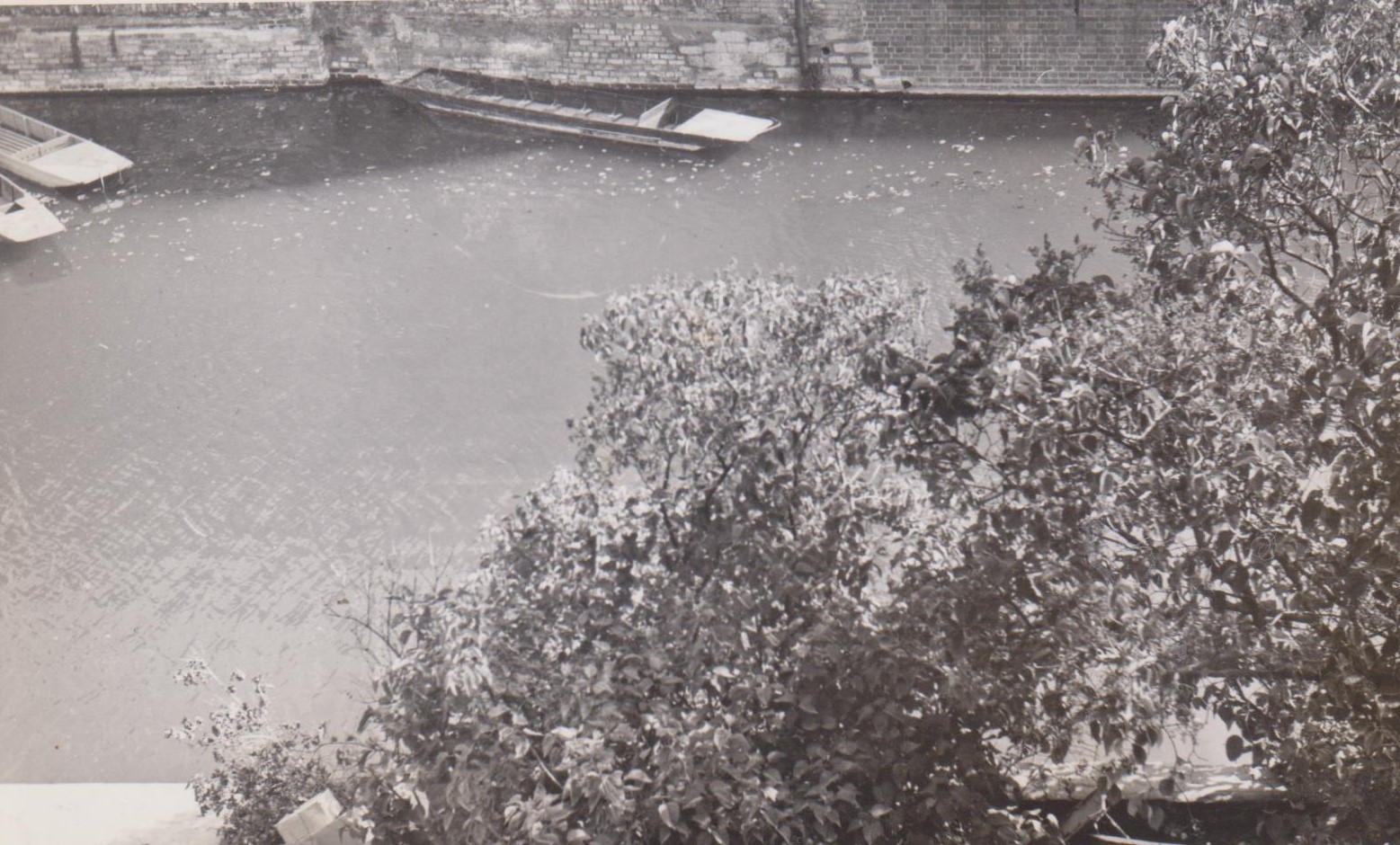
The Cam from Bright's Building. Once again, a view taken in early October 1964. A fellow inmate of Bright's Building has reminded me that, a few weeks later, the Cam Conservators drained the Town stretch of the river to recover abandoned bicycles, and for some time we were left gazing upon mud. Prior to the construction of an urban sewerage system in 1895, most colleges had kept clear of the Cam altogether and, even in 1964, the river was not a particularly romantic accessory. But my enduring, and negative, memories of Bright's Building were not of the view but of my room. I do not wish to over-dramatise. Expectations were lower sixty years ago and, at nineteen and away from home for the first time, I felt pleased and privileged to have my own space. My accommodation was certainly not poky: indeed, its echoing Edwardian expansiveness defied the faint efforts of the gas fire. The furniture was not so much Chippendale as chipped. (Traditionally, freshmen had been required to purchase the furniture in their rooms from the outgoing occupants. This was unfair to students with limited means and, in 1923, the College accepted the responsibility of furnishing the rooms. I suspect that a job lot was purchased at that time, and that the stock had become shabby over the next four decades. As with all 1964-vintage resources issues, it was only fair to bear in mind that there had been other challenges in the intervening period, e.g. a world war.) A small bedroom was portioned off in one corner, although the walls did not reach the ceiling. Perhaps the grimmest feature was the wallpaper. It was impossible to identify its original colour (perhaps from 1909?) but by the time I encountered it, the decor was an unrelieved spread of tobacco grey. I had hitch-hiked around Scotland a couple of years earlier, and decided to buy four rolled-up Ordnance Survey maps of the Highlands. These I sellotaped to the longest and bleakest stretch of wall, no doubt in defiance of regulations. The brightly coloured maps provided a conversation piece for visitors, one of whom cheerfully pointed out his family estate. I left my Bright's Building apartment without regret in the summer of 1965. I hope it has been redecorated since.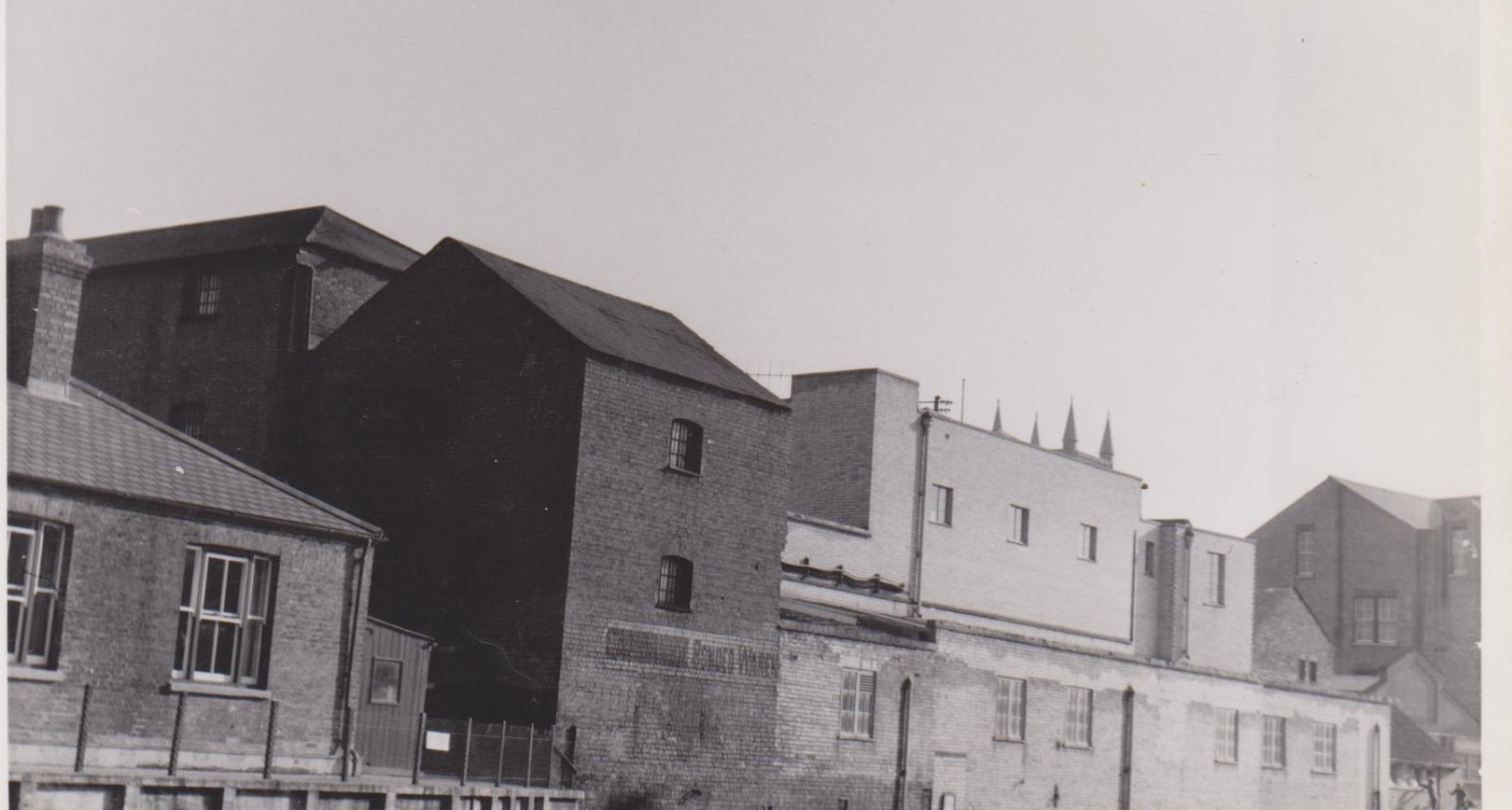
The view across the river. In an unpublished memoir by a Magdalene veteran who had been billeted in Bright's Building a few years earlier, the view across the Cam was described as "squalid". This I heartily endorse. This photograph was taken from the College gardens on 3 October 1964. I recall that I deliberately manoeuvred the camera to include a glimpse of the pinnacles on the chapel tower of St John's College. The angle of the shot may make it look as if the buildings were about to slide into the river, but – alas! – this was not true. Magdalene, it should be emphasised, was not responsible for this urban blight. Much of the land belonged to St John's. Indeed, just downstream, towards Jesus Green, loomed the chimney of the former electric power station, constructed in the eighteen-eighties and which had only recently ceased to shower Magdalene with soot. The College History calls it "perhaps the most unfriendly act ever perpetrated by a Cambridge college against one of its neighbours". Redevelopment by St John's around 1980 resulted in the building of apartments. A riverside walkway improved the local amenities. Between 1987 and 1990, Magdalene embarked on a large-scale project to upgrade its own Quayside properties. Nowadays, the College is located in a lively and cheerful part of Cambridge. It was not always so. My photograph makes no aesthetic claims, but it does show that the Magdalene of sixty years ago was hardly lost in a paradise of dreaming spires.
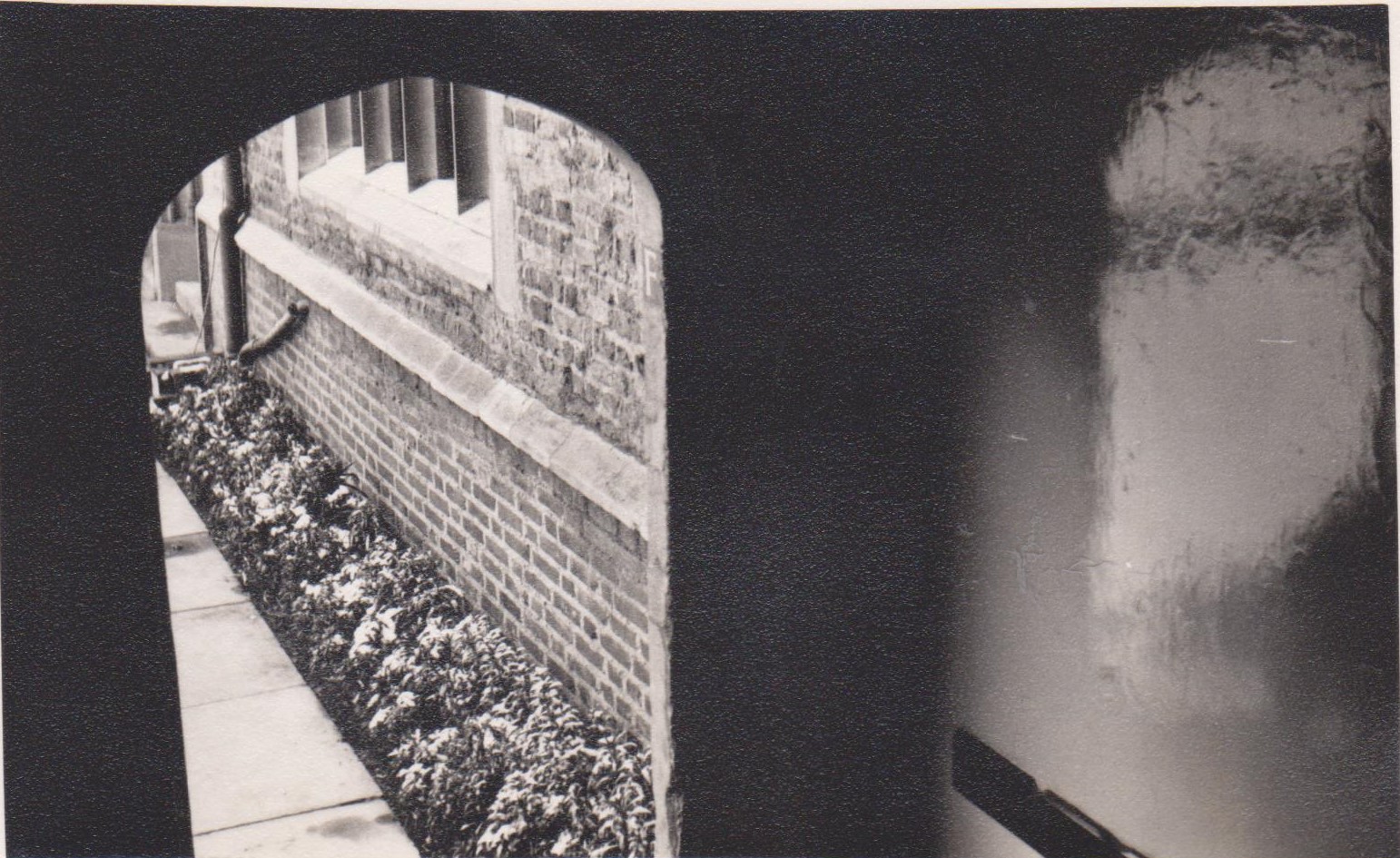
F staircase into First Court. The photograph was intended to capture an unusual glimpse of the College. F staircase in First Court was one of the segments erected by the Benedictine abbeys after 1476. Unlike the adjoining D and E staircases, which preserved their steep monastic ladders, F staircase had at some stage become modernised with returns and banisters. It gave access (and still does) to attic rooms that had been created when a ceiling was inserted under the rafters of the Hall in 1714. In 1964, the porters still referred to F staircase as "The Warren", although I think the term had gone out of student use. I have traced it back to 1839, and it was probably of eighteenth-century origin. Indeed, F staircase would soon become even more of a warren when the sets under the clock were converted into bed-sits.
As the numerical breakdown of the student community made clear, in 1964 postgraduates were hardly a major feature. (I suspect that some of the 41 recorded had stayed on to take the Dip. Ed. which was becoming a required career preparation for teachers, although few of the customers had a high opinion of the training they received. They had no reason to maintain any contact with the College at all.) I recall a couple of interesting PhD students who came to bread-and-cheese lunches that were held to raise money for War on Want, but otherwise the BAs were invisible. However, the creation of new graduate colleges in the mid-sixties forced the older institutions to acknowledge their research students. In 1967, F1, formerly a Fellow's set, became the Middle Combination Room (MCR). An extra Tutor was appointed with special responsibility for the welfare of graduate students and the central table in Hall was reserved, on Friday nights, for a BAs' dinner, which was a gastronomic cut above the usual undergraduate fare. It should be stressed that, in the late 'sixties, the Governing Body felt it had done its duty to its research students by arranging social space for them. The statement on today's website that "Magdalene tries to provide accommodation for as many postgraduate students as possible" would have been unthinkable. Collectors of College trivia may like to note that the MCR has now occupied F1 for more than ten percent of that apartment's five-and-a-half century existence.
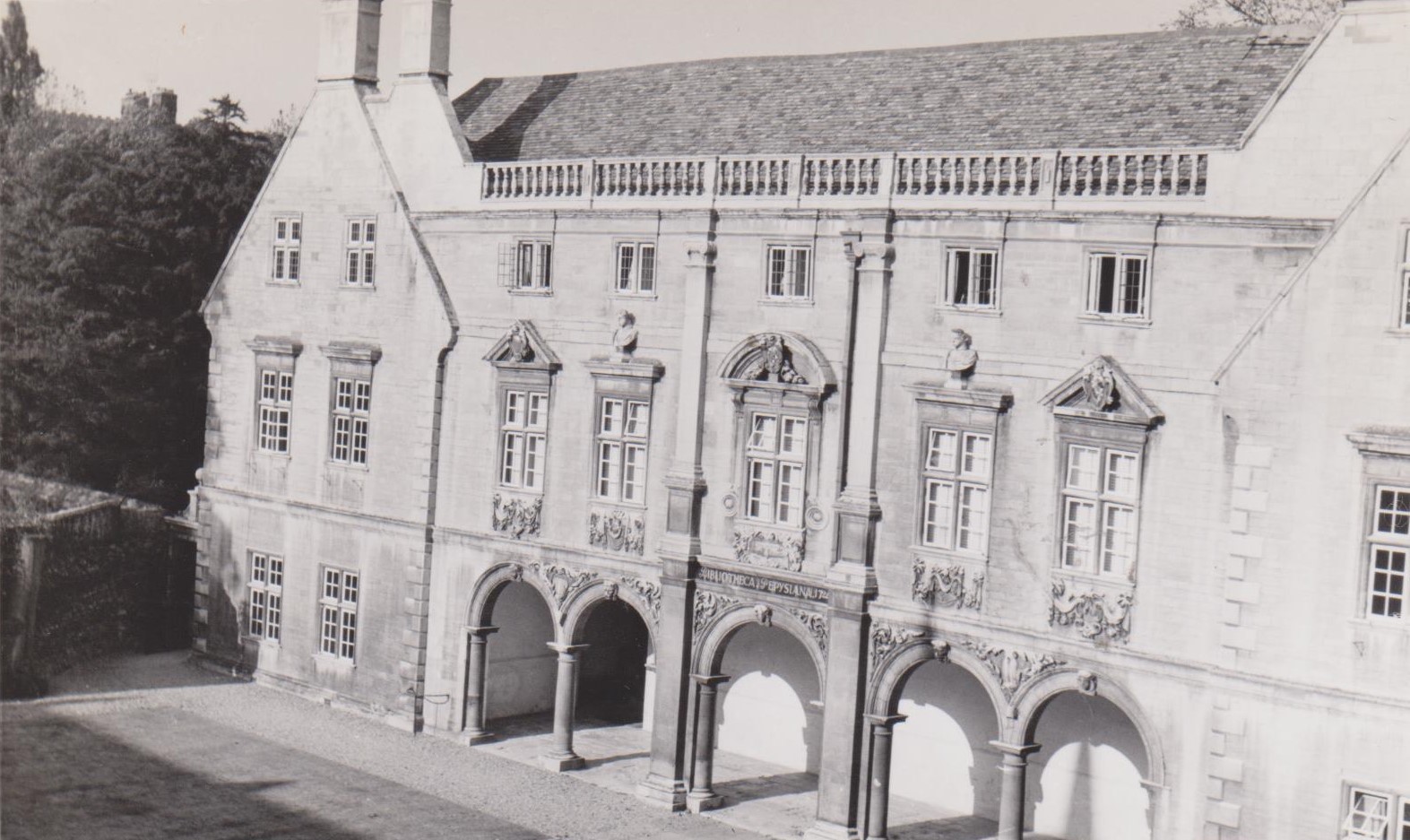
The Pepys Building. This is another photograph taken from Bright's Building on 3 October 1964. It could be called timeless, although the Pepys Building of 2024 owes a great deal to a major refurbishment carried out in the mid-eighties. Of course, it takes its name from the fact that it houses the library of Samuel Pepys: Bibliotheca Pepysiana as it announces over the cloister (which, actually, to architecture purists, is a loggia). In fact the Pepys Library only arrived in 1724 (300 years ago), while work on the building may have begun as early as 1640 and was mostly undertaken in the late sixteen-seventies. I do not claim that, as an undergraduate, I spent much time in the Pepys Library, but it was certainly a privilege to be able to drop in to such a magnificent collection, and I learnt enough about it to be able to act as a guide to visiting relatives and friends.
More important to a newly arrived undergraduate was the room behind the first floor window which can be seen intruding on the right-hand side of the photograph. This was the home of the College's undergraduate library. No great surprise here, one might think, since it was surely obvious that a Cambridge college would maintain a textbook collection in support of the degree studies pursued by its junior members. Well, yes – but only for the previous four years! Alongside the Pepys collection, the College had long maintained its own assemblage of books which was housed in First Court. Now known as the Old Library, it is also a treasure store of priceless material. However, beyond subscribing to some academic periodicals, it had made little provision to support student endeavour. In 1960, Magdalene finally decided to establish an undergraduate teaching collection, and the practice commenced of actually buying books, instead of relying upon donations – a pleasant custom, but not one guaranteed to acquire the most useful titles. Three years later, Dr Ronald Hyam was appointed as Librarian. Recently imported from St John's to teach History, he inherited a collection of 5,000 items, 2,000 of which he promptly discarded. By 1965, the undergraduate library contained 8,000 books, most of them selected because they appeared on Tripos reading lists. The first glimmerings of a new Magdalene were appearing.
Naturally, History was well served, a case not of jumping the queue but of setting a good example. I have much reason to be thankful for Ronald Hyam's energetic efficiency, not least because very early in my first term I developed an aversion to the History Faculty's own bossily administered collection of scruffy textbooks, the Seeley, then housed in the Senate House complex. In addition to his administrative skills, Ronald Hyam was also an accomplished calligrapher. His superb penmanship crafted signs and administrative notices that gave the undergraduate library an instant sense of timeless elegance (always a plus in Magdalene). He would hold office for thirty years, overseeing the purchase of 20,000 volumes.
As so often in Cambridge, those who accepted a new initiative tacitly assumed that it could somehow be squeezed into some cobwebbed corner of the status quo. Presumably it was assumed that this novelty of an undergraduate library would remain confined to a single converted first-floor set in Right Cloister. The more-or-less inevitable occurred, and over the next half-century the books steadily invaded adjacent chambers until they had eventually spread through most of the lower segments of the Pepys Building. The long-term solution was clearly a separate Library building. This finally came about (winning praise and prizes) in 2022.
In 1964, the undergraduate library was largely run on an honour basis. If you were the last student to leave, you locked up and delivered the key to the porters. Similarly, if you wanted access when it was closed, you collected the key from the lodge. To make it harder to lose, the key was attached to a large oval polished metal fob. Students sometimes jingled the combination as they strolled through the College, producing a cowbell sound to advertise their diligence. (In 2024, the Library is open 24/7.) Books could be borrowed, with users trusted to fill in the details on printed forms. These were stored on a spike.
Tucked into the bottom right of the photograph is one of the windows of the ground floor set at the front of Right Cloister that, according to Magdalene tradition, had been allocated to the nineteen-year-old Charles Stewart Parnell when he arrived in 1865. (He was addicted to sleep-walking and the College could not risk placing him upstairs.) I did not know much about Parnell in 1964 (I did not know much about anything, full stop, although I thought I did), but one evening I very shyly stopped Mr Salter, the senior History Fellow, in Second Court and asked him for a briefing. Frank Salter had come to Magdalene in 1909, he was in touch with the tradition and he was happy to share it. That conversation was the origin of a lifelong enthusiam. Over the decades, I have made sporadic attempts to understand the Irish leader, sometimes explaining my interest in him by saying that we were both at Magdalene, although not at the same time. In the mid-sixties, it was occasionally claimed that Parnell haunted the Pepys Building. All I can say is that I had rooms on Right Cloister for two years and I never encountered him. Since Parnell does not seem to have enjoyed his time at Cambridge, it is hard to see why his spirit might wish to return. Taking posthumous revenge for his rustication would hardly be fair on the lively and tolerant institution of today.
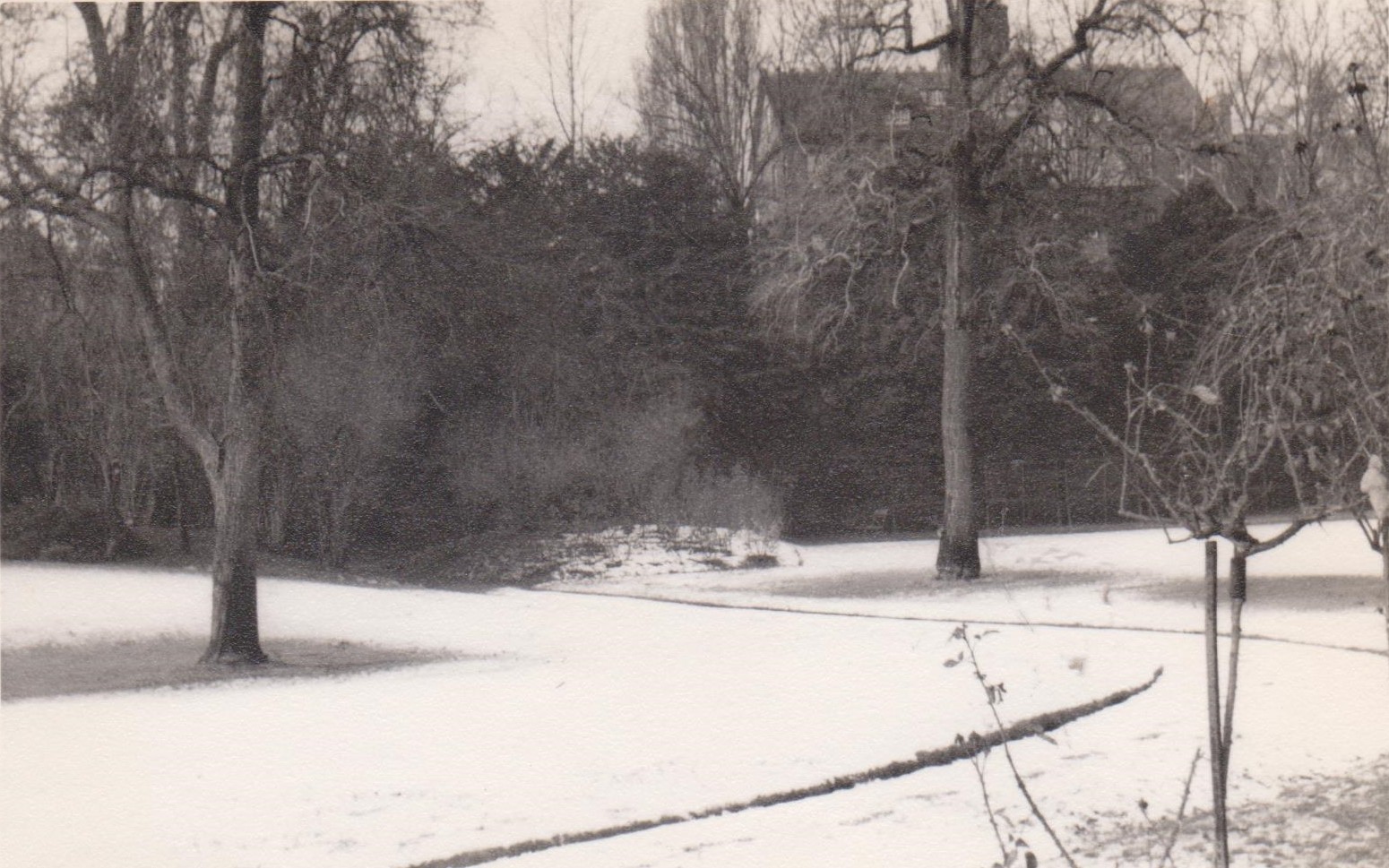
College garden in the snow, January 1965. This gloomy view peers into the north-west corner, the location of one of Magdalene's oddest features, the pets cemetery. In the nineteenth century, not only was the Master of Magdalene appointed by the Visitor, Lord Braybrooke, but the job was regarded as a perk for some member of his family. A younger son, Latimer Neville, was Master from 1853 until 1904. (Two of his older brothers were killed in the Crimean War, and two more failed to produce male heirs: Latimer Neville inherited the title in 1902 and, for the last eighteen months of his life, he was both Master and Visitor.) It is a commentary on the Magdalene of that era that the only trace of his half century of presiding over the institution should be the graves of his cats and dogs. Today, this corner of the garden is dominated by the new Library.
The College garden was reserved for Fellows until 1911, when access was granted to undergraduates. The pleasant open-plan combination of grass shaded by mature trees has long made it a convenient venue for large-scale outdoor events. In 1930, Albert Einstein ate an ice-cream on this very spot. He was attending a summer garden party after receiving an honorary degree in the Senate House. We did not know this in my undergraduate days, and I feel we might have regarded Magdalene as an intellectually more serious place had we been told. (The claim that Einstein was inspired by his visit to issue his most famous equation, Elysium = Magdalene College [squared], is entirely fictitious.)
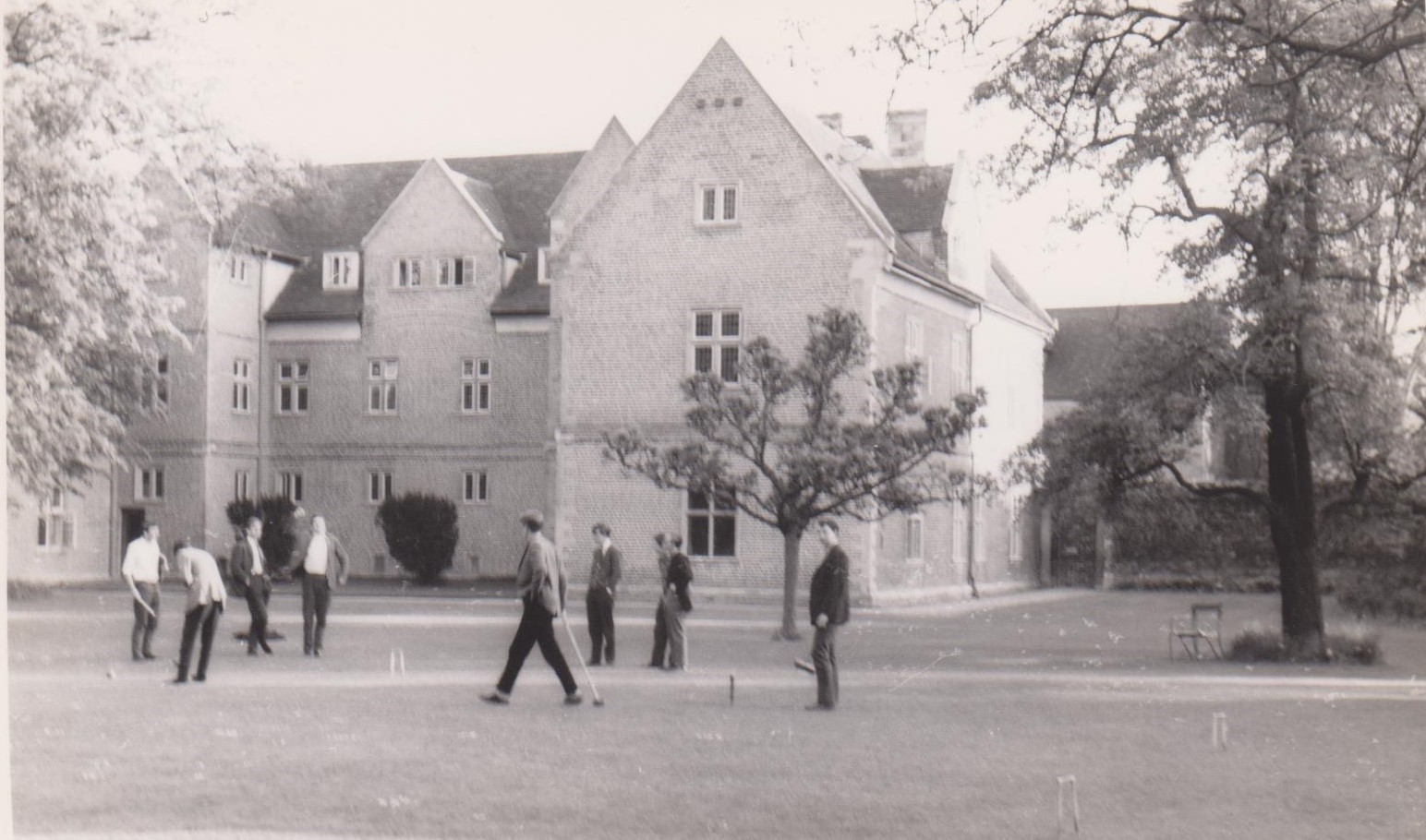
Croquet in the College garden. This photograph was taken on a summer evening in 1966. The triumphant figure was my friend Richard Petty, a popular Yorkshireman who died following a tragic accident in 1983. He is commemorated in the College garden by a stand of poplars and willow trees alongside the river, which were planted the following year. I hope they flourish.
The photograph prompts a few reflections. Nineteen-sixties Magdalene was sometimes portrayed as a Hooray-Henry, public-school institution. In reality, even those undergraduates who fell into the second category rarely belonged to the first. Eight of nine students in this picture (plus the camera operative) came from State or Direct Grant schools. (The latter were mostly old-established grammar schools which accepted government funding on condition of providing open access to suitable qualified local pupils.)
Magdalene was not only an all-male college but we were overwhelmingly English, with few Welsh or Scots. There were two students from West Africa in my year and, during the mid-sixties, the Governing Body elected bye-fellows from Malawi and Italy. Mickey Dias, the Law Fellow, was from Ceylon, while the Professor of Italian, Uberto Limentani, had come to Britain as a refugee from Mussolini's fascist regime in 1939. (He had been interned as an enemy alien, neither term being remotely appropriate.) That was about as international as the College could get. If there were any Americans, I do not remember them. I have no doubt that Cambridge was slow to adjust to the changing ethnic make-up of the British population but, in 1964, the New Commonwealth communities were still largely in the process of formation. Most of my cohort had been born in 1945 and 1946. The Empire Windrush, the symbolic beginning of large-scale immigration, had arrived from the Caribbean in 1948, and many of its passengers were young single men who were yet to establish families. In this respect, as in so many others, 1964 was a different world, and one that was about to undergo startling change.
A word about dress seems appropriate here. Although a few bold spirits wore jeans, most Magdalene undergraduates conformed to a basic outfit – slacks, sports jacket, white shirt and tie – especially for formal meals: this photograph was taken after Hall. On a summer evening, open-necked shirts were a sensible alternative. Sometime during my undergraduate years, a gruff edict was pinned to the Screens noticeboard reminding gentlemen (that was us) that we were expected to wear ties in Hall. There soon appeared next to it a hand-written diatribe in the name of an eighteenth-century Master, complete with fs for the letter S, which denounced the foppish novelty of tie-wearing. This was quickly removed, but the point that fashions change was presumably accepted, for there were no further sartorial exhortations. At that time, the Screens passage was protected from the elements by two solid but battered doors, battered because they were endlessly pushed and kicked open by passers-through. When the doors were closed at night, the porters had no line of vision to the noticeboards, which made it possible to pin the protest alongside the original diktat. Not long afterwards, handsome swing doors were installed, with glazed panels that permitted light to enter the Screens passage and enabled the porters to keep an eye open for possible sabotage. I believe they are still in use.
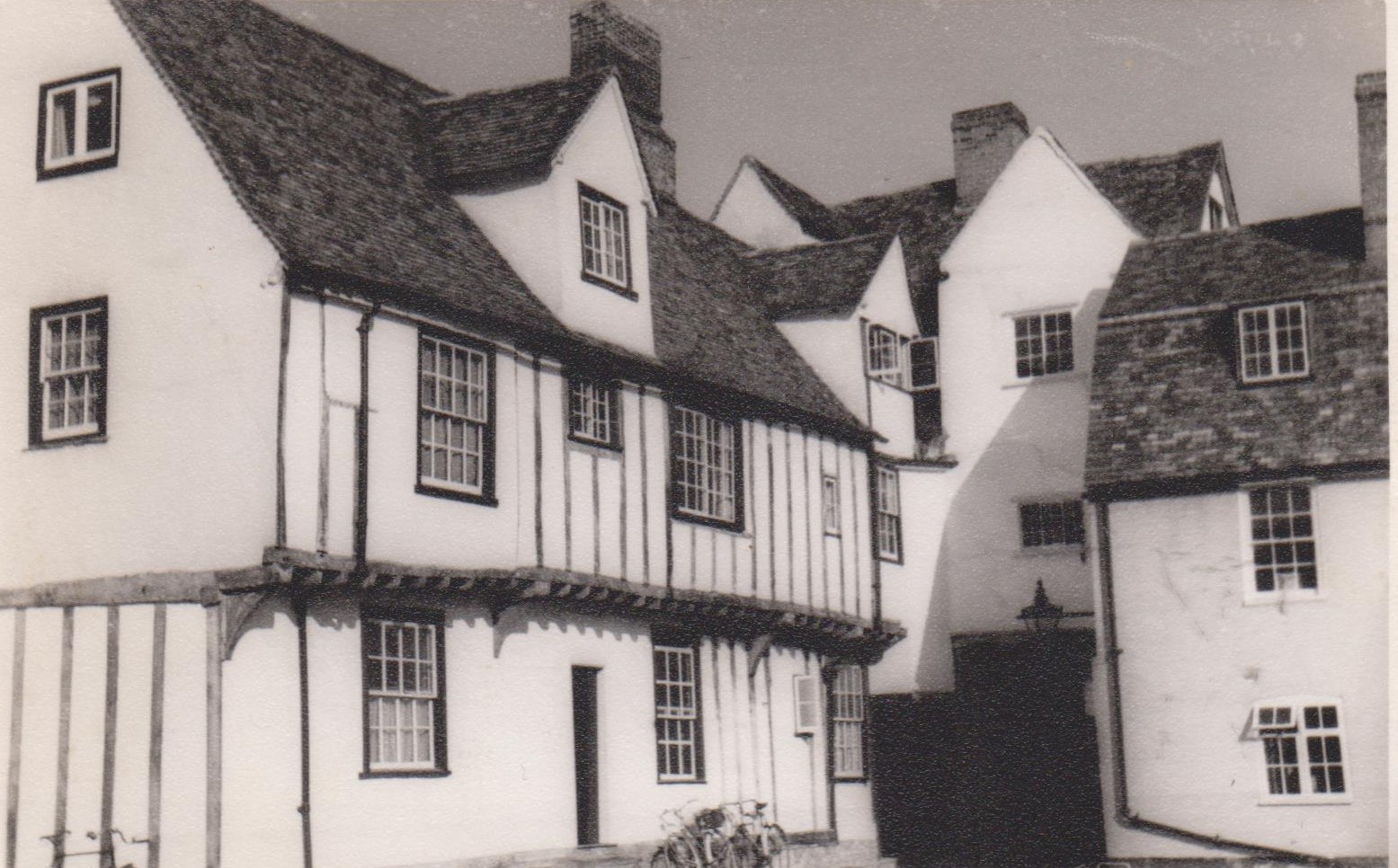
Cross Keys Yard. This photograph of H, J and K staircases in Benson Court was taken during 1964-5 because a good friend had rooms here. The major problem about living on K staircase, part of the former Cross Keys Inn, was that it had projecting upper floors which were a frequent target for high vehicles. I suspect that this picture taken across the courtyard could be replicated sixty years on, except that the provision of bicycle stands has discouraged the untidy stacking of bikes.
This seems a good place to point out that the standard unit of College accommodation in 1964 was still the set, with a separate sitting room and bedroom – even in the cramped and ancient space of Cross Keys Yard. There were some exceptions: a few of the large apartments in the Lutyens Building were used for double occupancy, which meant that the student in the bedroom had to pass through the personal space of the student in the sitting room, an infringement of privacy that did not always work. Not long afterwards, an internal reconfiguration turned these Lutyens rooms into bedsits, each with its own entrance. Magdalene perhaps hung on to its sets for longer than most colleges. One defence offered at the time was that the post-Second World War student generations included many heavy smokers, and separate bedrooms reduced their exposure to tobacco fug. But by the end of the decade, sets were on the way out. The larger rooms were increasingly needed for library and office use, while (wherever it could be done) division of accommodation into two units made it possible to squeeze in more undergraduates.
In 1964, it was Magdalene practice that all undergraduates spent their first year in College. In that era, it was possible to compete for Entrance Scholarships (worth £60 a year) and Exhibitions (£40) through examinations held the previous December. Scholars were entitled to rooms in College through all three years, Exhibitioners for their first two. (Separate Cambridge entrance examinations came to an end in 1987.) Everyone else was decanted into hostels and digs in second year. Third year students could make a claim for rooms in Magdalene if they were officers of College or University clubs and societies: cynics alleged that exotic societies were sometimes formed solely with the purpose of securing in-College accommodation.

Magdalene Bridge from Benson Court. The Cam, the wintry dangling willow branches and the buildings of N staircase, Benson Court, may all be timeless, but I believe the view has improved. There is now a restaurant with a riverside terrace just across the bridge – and Quayside beyond is a great deal smarter. This is a gloomy winter shot, taken when the punts that usually clustered just downstream had been put into hibernation.
The curious thing about the bridge itself is that Magdalene in the mid-sixties had no idea that its neighbour and namesake was an impressive early example of a cast-iron single span, and that it was remarkable that it was still carrying traffic. There was a date, 1823, in the ironwork, but nobody seemed to notice it. Unfortunately, in 1970, planners decided that this relic of the Industrial Revolution was not carrying enough traffic, and that it needed to be replaced by a structure that could bear even heavier loads. Magdalene fought back, one Fellow calling the scheme "the worst act of folly that has been committed against Cambridge for a century or more". Ralph Bennett, who taught medieval history, made himself into an instant expert on industrial archaeology and displayed a messianic ingenuity of presentation that virtually turned the threatened monument into the Eighth Wonder of the World. John Dwight, Magdalene's Fellow in Engineering, produced an alternative technical assessment, which argued that the structure could be strengthened to carry its existing load. Increasingly, the College asked why there should be so much heavy traffic rolling into the narrow city centre streets anyway, and much play was made with soon-to-become ecological bad-buzzwords such as congestion and pollution. The controversy rumbled on for a decade, and so did the traffic. Warning notices advised that heavy vehicles were banned, but these were not always obeyed. When I pointed out to one lost driver who was seeking directions that his truck was obviously over the weight limit specified on the sign, he pleaded the same visual defect that Lord Nelson had experienced while visiting Copenhagen in 1801. Eventually, work began in 1981 on a huge project to shore up the old bridge, and for the next two years traffic was siphoned over a temporary crossing slightly downstream and through River Court. For once, Magdalene found itself on a winner, since the College was well paid for the inconvenience incurred, and had cash in hand to tackle the refurbishment of River Court when the work ended in 1983. The joke was that the original structure was found to be in excellent condition and had never been in need of replacement, nor indeed of much additional support. All this happened, of course, well after my undergraduate days, but it remains curious that the College only became interested in the bridge when its removal was threatened in 1970. After all, the structure had given its name to the town, and its mention in the Anglo-Saxon Chronicle for the year 875 was the first recorded example of the word (brycg) in the English language – the sort of just-fancy-that antiquarianism which ought to have appealed to traditional Magdalene donnishness. (The bridge was 200 years old in 2023: did anybody notice?)
When I wrote about the origins of Benson Court, I was astonished to discover that, back in 1928, the famous architect Sir Edwin Lutyens had assumed that the bridge would one day be rebuilt, and that it would become possible to construct an underpass linking the old and new sides of Magdalene. As this photograph makes clear, there was very little headroom, and it is hard to see how any tunnel could have provided more than a hands-and-knees subway. I have explored this conundrum on https://www.gedmartin.net/martinalia-mainmenu-3/341-magdalene-cambridge-lutyens-building.
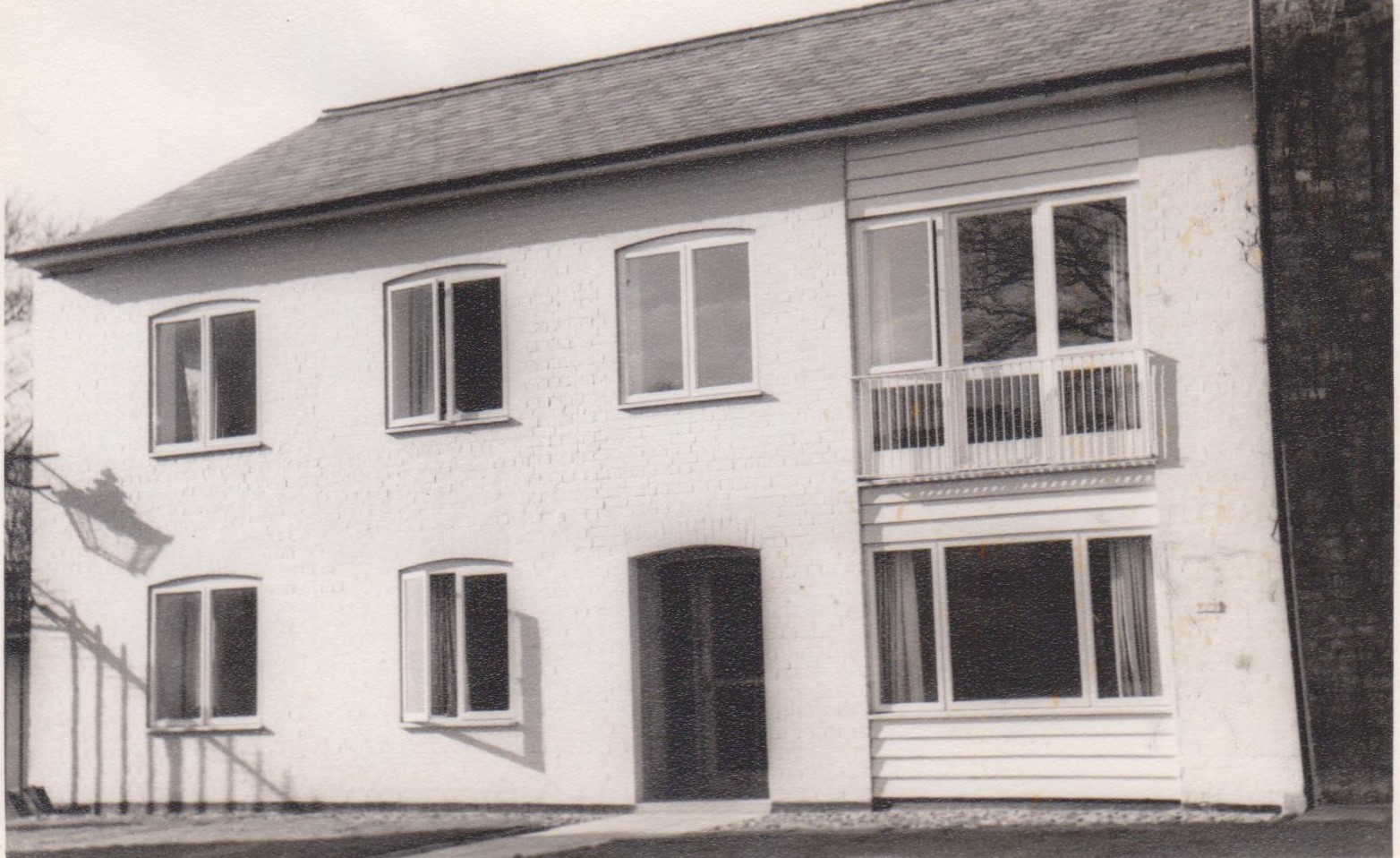
Mallory Court, A staircase. In 1952, the Governing Body finally and mercifully abandoned the grand[iose] scheme of Sir Edwin Lutyens for a three-sided red-brick canyon of a courtyard, and commissioned David Roberts to produce a mix of conversions and infill that would treat the five completed Lutyens staircases of A to E Benson Court as a ponderous backdrop. Mallory Court A was an example of the smaller-scale new-build that contributed to the 'village' campus. By 1964, Benson and Mallory Courts were complete: Buckingham Court was to follow at the end of the decade. There followed a thirty-year pause in large-scale construction before work began on Cripps Court in the new Millennium.
The obvious question to ask – in retrospect, for it hardly occurred to the student body of 1964 – was how on earth did Magdalene manage to spend so much on new buildings, when it also faced considerable outlay saving its existing estate – and was notoriously the poorest of the seventeen 'ancient' colleges? In 1926, Trinity had been about thirteen times richer than Magdalene. Since then, the gap had actually widened: by the early twenty-first century, Trinity would be more than twenty times wealthier. The answer, as we were all vaguely aware in our undergraduate days, was that the work had been funded by the generosity of the College's alumni. In the latter years of my own academic career, universities made great play with the slogan "doing more with less". Between 1950 and 1970, Magdalene managed the far more remarkable feat of doing a great deal with almost nothing at all.
This reliance upon alumni goodwill had one inherent disadvantage. The core group of long-time Fellows who ran the institution were in any case averse to change, but the College's reliance upon the generosity of former students gave them a knock-down argument against any reformist suggestion. Admit women? "The old members would not like it" was the coded translation of "Over my dead body". In vain was it pointed out that Magdalene men had probably also sired daughters and might wish their girls to have the Garde Ta Foi experience. In fact, when the Governing Body finally confronted the issue of admitting women in 1986, it decided to invite all members of the College to offer their opinions. Of course, this was a consultative trawl, not a scientific survey, but 55 percent of the 1,200 replies either favoured or accepted the change. Thus, on what had so sadly become the central defining issue of Magdalene's institutional conservatism, the negative consensus among the resident dons had been overtaken by the majority of the College's own products. (Whether this would have been true twenty years earlier, it is of course impossible to say, but the 1986 write-in apparently revealed surprisingly high levels of acceptance among veterans from the nineteen-fifties.) Interestingly, the College Magazine reported that one of the "less altruistic" reasons for favouring change was the hope that their daughters and grand-daughters might one day follow in their footsteps.
It should also be made clear that contributions to Magdalene appeal funds did not allow alumni to buy places in the College for their sons. Magdalene did not follow the practice of "legacy admissions", adopted by some famous Ivy League universities in the United States. There were no doubt defects in the Cambridge admissions process, which did not always effectively distinguish between innate ability and good teaching. But it is only fair to my contemporaries to make clear that I do not believe that any student's path into Magdalene was smoothed by parental munificence. Indeed, not many undergraduates were the sons of – to use a grisly phrase – Old Magdalene Men. Those few who were following a family tradition showed themselves quietly determined to prove they had won their places through their own ability and diligence.
The shadows across the wall of Mallory Court A are explained in the discussion of the next (and last) photograph.

Leaving Mallory Court. In 1964, Magdalene College stopped at Mallory Court. Handsome gates and wrought-iron railings filled the gap between Mallory A and Benson E. I believe they provided a climbing-in route for late-night revellers who lived on that side of the road. The view in this photograph would soon radically change. By 1967, the ivy-covered penitentiary-like rear wall of St John's New Court was obscured by the Portland stone facing of Powell & Moya's dramatic Cripps Building. Then, in 1968-70, Magdalene slotted into the right of the picture the red-brick block of Buckingham Court. The barrier was removed. Just beyond the railings can be seen a small cluster of garages, provided for Fellows to house their cars. Since the core of the Buckingham Court building was a huge covered car park, these were no longer required, and all trace of them was swept away. I was told at the time (College rumour was not always the most reliable source of information) that part of Buckingham Court was inadvertently erected on land belonging to St John's, a curious blunder if true. However, for once – and, for the first time in their histories actually meeting at a land frontier – the two colleges harmoniously adjusted their differences. Indeed, Magdalene gained the inestimable benefit of generous financial support from Humphrey Cripps, whose Foundation had made possible the named buildings in St John's. This benign association would further enrich Magdalene in the future.
On E staircase in Benson Court, partly visible on the left of the photograph, were the rooms of Prince Richard of Gloucester. Even in those innocent days, it is perhaps surprising that a member of the Royal Family could be located right on the College periphery, easily accessible to potentially malevolent outsiders. Yet I do not recall any visible security precautions, nor were there Tutorial edicts or donnish homilies about his presence in the College. Rather, it was tacitly accepted that his three years as an undergraduate might be the only opportunity he would have to live anything like a normal life (assuming, of course, that Magdalene equalled normality) and it was understood that he should be treated like any other member of the College. He sensibly adopted a low profile and I suspect that some of my contemporaries did not even know him by sight. Prince Richard graduated in 1966, taking his BA in Architecture and Fine Arts. As HRH The Duke of Gloucester, and an Honorary Fellow of Magdalene, he performed the opening ceremony for the new Library in 2022.
Reflection. In every epoch of its history – at least until recent times – Magdalene has been run by relatively small coteries of dons who have successively attempted to shape its ethos and sometimes even to dictate its collective values. But there has usually been room for internal diversity and, hence, many different Magdalenes have shared the common space, often ignoring one another, sometimes coming into contact and working out how to get along. Those of my contemporaries who possess the computer skills and the patience to wade through this presentation may perhaps feel that my undergraduate experience did not reflect their own. I can only hope that my photographs, murky and misty though some of them may appear, can help others to recall vivid memories of their Magdalenes. To my long-range successors in the College of today, I would say that Magdalene has always been the product of overlapping blocks of time, like the bonding of bricks in a wall. As I type these concluding thoughts, I certainly have aching and creaking personal reasons to recognise that I became an undergraduate A Long Time Ago. But there is a sense, too, that 1964 was also relatively recent and that, in some respects, it maintains tenuous connections with the institution of the present day. Perhaps most noteworthy of all, the Magdalene that I encountered was in the process of change without always being aware of the fact, and that, in 1964, it was about to enter a new, bewildering and even fundamentally transformational phase (although those who ran the institution fought something of a rearguard action through the lost decade of the nineteen-seventies). But no doubt constant confrontation with the need to adapt is equally true of the College today, and has been so at almost any time since 1904. Whatever may be the challenges that it has to face, Magdalene will doubtless continue to assimilate revolutionary change within its unflappable posture of timeless tradition.
Information for this essay has been drawn from Magdalene Described: a Guide to the Buildings of Magdalene College Cambridge (by Ronald Hyam, assisted by Aude Valluy-Fitzsimons), published by the College in 2011. This has been supplemented by Simon Bradley and Nikolaus Pevsner, The Buildings of England: Cambridgeshire (2014). I have also relied upon A History of Magdalene College Cambridge 1428-1988, which appeared in 1994 and was written by the team of Peter Cunich, David Hoyle, Eamon Duffy and Ronald Hyam. Some snippets have been taken from E.K. Purnell, Magdalene College (1904), and from various issues of the College Magazine.
Around thirty Internet essays and notes relating to the history of Magdalene College are listed on:
https://www.gedmartin.net/martinalia-mainmenu-3/372-magdalene-history-on-ged-martin-s-website. I appreciate the friendly interest in the material shown by many members of Magdalene, but (as always) I must stress that my various narratives and speculations are the result of a personal interest in Cambridge history and do not (indeed, could not) imply any official endorsement by the College.